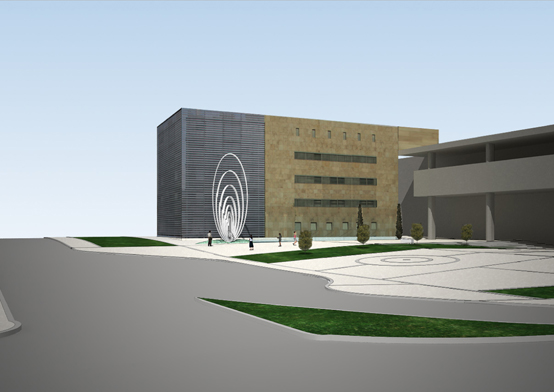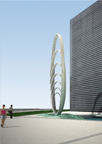




The Letter of The City
Concept
The general requirement of the competition was that the character of the sculpture should refer to the history and evolution of the city of Thessaloniki and its culture.
Basic Concepts :
Repetition, Succession, Recurrence, Shift.
Extroversion - Introversion, Analysis of the Self
The sculpture recurs to itself
The sculpture consists of seven successive ellipses, which allude to the recurring materiality of history. The ellipse as a form was chosen because of its clear axis of movement. Its long axis indicates movement towards a direction, while simultaneously beginning from where it began. Additionally, as a form, the ellipse constitutes a diachronic abstract signifier which discreetly refers to the “Θ”, the letter of the City.
The successive ellipses illustrate that, during the process of its development the city always returns to the beginning of its history - an unconscious and ever shifting beginning - in order to proceed to the next stage of development. This process of repetition and succession, and finally shift, highlights the historical beginning as a unique and dense shifting stage and the progress-development as a diachronic process of introspection and morphic self-reference.
The form of the sculpture at first glance appears to be symmetric. However it is not. The vertical rotation and shift of the elliptical rings, orients the sculpture towards the moving pedestrian, creating successive views. The interruption of the ellipses at the highest part of the sculpture as well as the gradual stepped formation at its lowest part constitute two morphic episodes within the elliptical recurring course. All sculptural elements address themselves to people passing by, inviting them towards the internal core of the sculpture that simultaneously becomes extrovert passing towards the other, “back”, side of view of the sculpture.
The sculpture through its rotation creates multiple elevations and view-levels. The two main elevations are the initial and the final ellipse. The first is materialized by the largest exterior ellipse and the other by the smallest internal ellipse. These two ellipses highlight the psyche of the city by exposing simultaneously its exterior form as well its inner core. The exterior form and inner core are related via a non-linear process. Each time, in order to proceed to the next historical step, the “orbit” of History refers back to the “beginning”. The city recurs to itself and thus is reborn, but its ground does not “change”, since the initial core is incorporated in each new step. Thessaloniki “comes back” to the beginning of its History in order to give birth and solidarity to a multitude of different cultural identities.








The sculpture relates to the building and the plaza through rotation of the two primary views. Furthermore the size of the ellipses relate to the surroundings through a scalar proportions. For example the exterior ellipse addresses itself to the square and to the broader context of the city, streets, parks, beach, and so on. While the interior ellipse is rotated and shifted in towards the entrances of the Town-Hall, addressing itself to the square and the Town-Hall. The scale of the sculpture relates to the proportions of the building without exceeding its height it or degrading it. The sculpture is 11 meters height and 4.36 meters wide. Its size converts the metal construction of the building facade into screen on which the outline of the sculpture is projected.
The base for the sculpture is created by copper waves, which come out from the water and shape the base of the sculpture. Water runs between the copper waves in shaped channels, which lead to the pool of water on the western side of the building. The construction of a small bridge is also proposed in order to encourage the interaction between the viewer, and the sculpture and water elements, offering also the possibility for the sculpture to be viewed from all around.
MATERIALS
The materials for the purposed construction are, stainless steel for the main sculpture, and oxidized copper for the base. Stainless steel is a modern material, clean, reflective and transcending in the light, and diffusing into the environment. The steel signifies the renewal, the rebirth and the regeneration. Oxidized copper is an ancient material, comprehensive and vivid. Copper is in a process of continuous interaction with the natural conditions and the light, and its immediate environment. It signifies the beginning of history, and the morphogenetic cultural conditions. The water running through the copper base is a continuation of the existing pool. Water is a natural and living material. It signifies nature, birth, and movement and the source of natural history to the present.
LIGHTING
The sculpture relies predominantly on an internal lighting scheme. Accent light sources are placed within the seven steps of the internal staircase lighting upwards, and within the seven gaps created by the shift of the elliptical elements lighting downwards. In this way each ellipse casts light on the adjacent ellipse, thus all parts of the sculpture are highlighted during the night. In addition two auxiliary lights are placed in the base for the diffuse lighting of the sculpture.








Thessalonikis New Town Hall Sculpture Competition 2010. http://www.thessaloniki.gr
The competition was organized by the Municipality of Thessaloniki.
Requirement: The character of the sculpture is required to refer to the history and evolution of the city of Thessaloniki and its culture.
The intellectual property rights belong jointly to Anamorphosis Architects & Fortsas Studios.


Project Title:
The Letter of the City
ANAMORPHOSIS Architects:
Nikos Georgiadis, Tota Mamalaki, Kostas Kakoyiannis, Vaios Zitonoulis
Sculptor:
Dimitris Fortsas
http://fortsas.gr
Design Team:
Jose Carlos Gonzalez Leal, Jed Laver, Marzena Parniak, Archontis Karanasios
